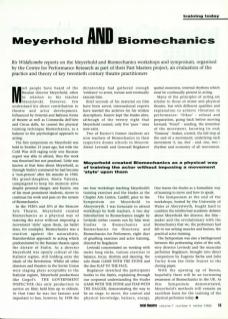Most people have heard of the Russian director Meyerhold, often in relation to his teacher Stanislavski. However, few understand his direct contribution to theatre and actor development. Influenced by Oriental and Balinese forms of theatre as well as Commedia dell'Arte and Circus skills, he created the physical training technique Biomechanics, as a balance to the psychological approach to acting.
The first symposium on Meyerhold was held in Sweden fifteen years ago, but with the Cold War still raging only one Russian expert was able to attend, thus the work was theorised but not practised. Little was known at that time about Meyerhold, as through Stalin's command he had become a 'non-person' after his murder in 1940. His grand-daughter, Maria Valenta, campaigned to keep his memory alive despite personal danger, and Kustov, one of his most prominent students, strove to continue his work and pass on the system of Biomechanics.
In the 1920s and 30s at the Moscow Arts Theatre, Meyerhold created Biomechanics as a physical way of training the actor without imposing a movement 'style' upon them (as ballet does, for example). Biomechanics was a reaction against the naturalistic, Stanislavskian approach to acting which predominated in the Russian theatre upon the dictate of Stalin. As a director Meyerhold was openly critical of the Stalinist regime, still holding onto the ideals of the Revolution. Whilst all other directors and theatres in the Soviet Union were staging plays acceptable to the Stalinist regime, Meyerhold productions like Gogol's The Government Inspector (his only production to survive on film) held him up to ridicule. At that time he was too famous and important to ban; however, by 1938 the dictatorship had gathered enough 'evidence’ to arrest, torture and eventually execute him.
Brief seconds of his material on film have been saved, international experts have trawled the archives for his written descriptions. Kustov kept the études alive, although of the twenty eight that Meyerhold created, only five 'pure' ones now exist.
Two of Kustov's former students are now teachers of Biomechanics in their respective drama schools in Moscow. Alexei Levinski and Gennadi Bogdanov ran four workshops teaching Meyerhold's training exercises and the études at the Chapter Arts Centre, Cardiff, prior to the Symposium on Meyerhold in Aberystwyth. I was fortunate to attend workshops by both teachers. A two-day Introduction to Biomechanics taught by Levinski (other courses run by him were Studies in Biomechanics and Biomechanics for Directors) and Biomechanics for Performers, eight days of gruelling exercises and actor training, directed by Bogdanov.
Meyerhold created Biomechanics as a physical way of training the actor without imposing a movement ‘style' upon them
Levinski concentrated on working with metre-long sticks, various exercises in balance, focus, rhythm and dancing, the solo étude Game with the Stone and the duo Slap to the Face.
Bogdanov stretched the participants bodies to the limits, explaining the études Game with the Stone and Stab with the Dagger, demonstrating the way to be on stage, to move, the control and physical knowledge, balance, energy, spatial awareness, internal rhythms which must be continually present in acting.
Many of the principles of acting are similar to those of mime and physical theatre, but with different qualities and explanation to achieve vibration in performance: ‘Otkaz’ – refusal and preparation, going back before moving forward; 'Porsyl' – sending, the intention of the movement, knowing its end; ‘Tormosa' – brakes, control, the full stop at the end of a movement; underlying each movement ‘é, ras, dva’ – and, one, two rhythm and economy of all movement.
One learns the études as a formalistic way of learning to move and how to speak. The Symposium at the end of the workshops, hosted by the University of Wales at Aberystwyth, fought hard to combine the intellectual academic debates about Meyerhold the director, the film-maker and the revolutionary with the Biomechanics that we, the performers, had felt in our aching muscles and bruises, the practical actor training.
The Symposium was also a battleground between the performing styles of the soft, wiry director Levinski and the muscular performer Bogdanov, brought into direct comparison by Eugenio Barba and Julia Varley from the Odin Teatret in the closing paper.
With the opening up of Russia, hopefully there will be an increasing awareness of Biomechanics in the UK. As this Symposium demonstrated, Meyerhold's methods still remain an excellent basis for the training of the physical performer today.

